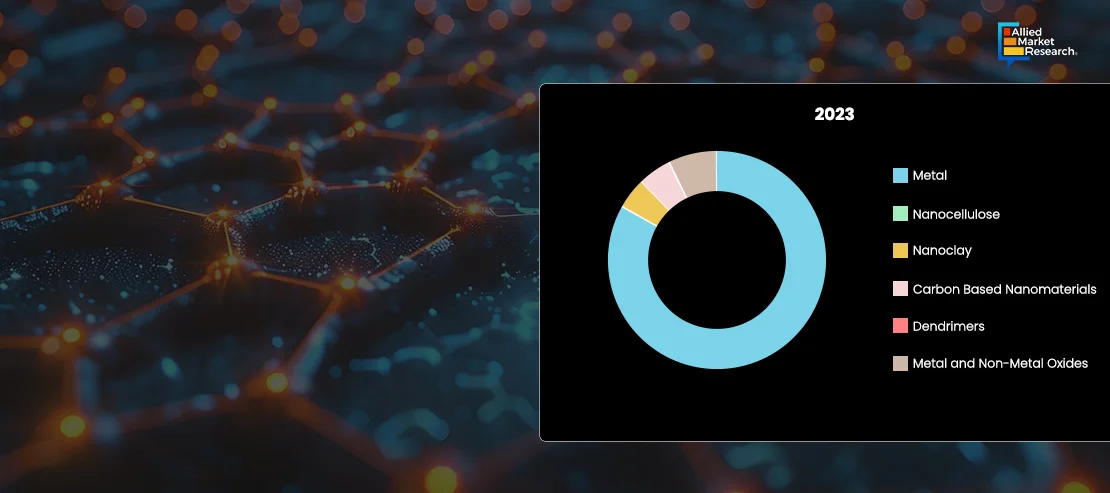Table Of Contents
- From Ancient History to Modern Science
- Signifying the Synergy of Sustainability and Nanomaterials
- Environmental Remediation
- Energy Efficiency and Storage
- Green Manufacturing
- Agriculture and Food Security
- Elucidating the Incorporation Level of Various Nanomaterials
- Deciphering the Developments that Drive the Industry
- Futuristic Frontier

Yerukola Eswara Prasad

Akshata Tiwarkhede
Nanomaterials: Navigating the Path of Success and Sustainability

The term "nanotechnology" was coined by Norio Taniguchi, a Japanese scientist, to describe precision machining at the nanometer level. Nanomaterials are nanometer-scale structures with at least one dimension less than 100 nanometers. They exhibit various properties such as high strength, hardness, elasticity, electrical conductivity, antibacterial effect, self-cleaning effect, scratch resistance, and chemical resistance, which make them ideal for use in different sectors. For instance, nanomaterials majorly find their application in electronics to device functionality, improve efficiency, and most importantly achieve miniaturization. In addition, they have made major contributions in the fields of targeted medication delivery, and imaging, and diagnostics, thereby improving treatment effectiveness and patient care. Furthermore, nanoscale components play a crucial role in energy preservation and carrying out environment-friendly manufacturing procedures, with increasing focus on sustainability. Thus, spanning from medicine to modern manufacturing processes, nanoparticles have been shaping the growth trajectory of various fields of science and technology.
From Ancient History to Modern Science
Although the term nanotechnology was coined by Norio Taniguchi, the concept was introduced in 1959 by Richard Feynman in his speech, “There’s Plenty of Room at the Bottom.” This speech emphasized on the fact that by using a material in its smallest form, it is possible to learn much more about the phenomena exhibited by the material, especially when presented in complex forms.
Nanoscale materials have been used for more than 4000 years without understanding the science behind them. Recent scientific studies have also stated that ancient Egyptians used a lead-based dye, which contained synthesized nanoscale crystal of lead sulfide. The first recorded instance of using nanomaterials was in the Lycurgus Cup—a Roman glass cup. The cup changed its color when light passed through it due to the presence of nanoparticles of gold and silver. Buckminster fullerene (C60, also known as buckyballs) was discovered by Harold Kroto, Richard Smalley, and Robert Curl in 1985; while Sumio Iijima discovered carbon nanotubes in 1991, which are cylindrical nanostructures with remarkable mechanical, electrical, and thermal properties. In addition, the industries such as medical, construction, and art have been using many clay minerals since thousands of years that contain naturally sourced nanomaterials from synthesized from wildfires, volcanoes, sea spray, dust storms, and other natural processes that create nanoscale materials. These early applications, though not understood in terms of nanoscale science, laid the groundwork for future exploration.
In the twentieth century, the advent of electron microscopy enabled scientists to observe and understand materials at the nanoscale. Presently, nanoparticles are integral to a multitude of applications, from targeted drug delivery systems in medicine to enhancing the strength and durability of materials in manufacturing. Currently, rapid advancements in nanomaterial synthesis and characterization techniques are being conducted, leading to the development of a wide range of nanoscale materials such as quantum dots, nanowires, and graphene. This progression reveals that nanoparticles are engineered with precision and are integral to innovations in medicine, electronics, energy, and environmental sustainability.

Signifying the Synergy of Sustainability and Nanomaterials
Nanomaterials offer several sustainability solutions across various sectors due to their unique properties, such as high surface area, reactivity, and mechanical strength. Some of the major use cases include:
Environmental Remediation
Nanoscale materials such as graphene oxide and carbon nanotubes can remove contaminants, heavy metals, and pathogens from water more efficiently than conventional methods. Nano-catalysts and nanofibers can capture and degrade pollutants like volatile organic compounds and nitrogen oxides.
Energy Efficiency and Storage
Nanoscale materials like quantum dots and perovskite nanoparticles can enhance the efficiency of solar cells, making renewable energy more viable. They further improve the capacity, charge–discharge rates, and service life of batteries and supercapacitors, essential for energy storage solutions.
Green Manufacturing
Nanocatalysts can increase the efficiency of chemical reactions, reducing the need for harsh chemicals and lowering energy consumption in industrial processes. Nanocomposites and bio-based nanomaterials can replace traditional materials, leading to lighter, stronger, and more sustainable products.
Agriculture and Food Security
Nanoscale materials can be more efficiently absorbed by plants, reducing the amount of chemicals needed and minimizing environmental impact. They further improve the barrier properties of packaging, extending the shelf life of food and reducing waste.
Thus, the integration of nanoscale materials fosters sustainability by enhancing energy efficiency, reducing pollution, and promoting eco-friendly agricultural practices.
The application of nanoscale materials is a transformative force across multiple sectors, driving advancements.
- Medical and Healthcare : They can target drug delivery more precisely, reducing dosage and side effects, and improving the efficacy of treatments. Nanosensors can detect diseases at very early stages, allowing for prompt treatment and reducing the overall burden on healthcare systems.
- Construction and Infrastructure : The inclusion of nanoscale materials like nano-silica can improve the strength and durability of concrete, leading to longer lasting and more sustainable infrastructure. Nanomaterials in insulation can significantly improve energy efficiency in buildings by enhancing thermal properties.
- Consumer Products : Nanoscale materials can be used to create more durable, self-cleaning, and water-repellent fabrics, reducing the need for frequent washing and chemical treatments. In addition, they help create more energy-efficient electronic components, extending the life of devices and reducing electronic waste.
As research progresses, the scope and impact of nanoscale materials will continue to expand across diverse industries in the coming future.
However, the potential risks associated with nanomaterials, such as environmental impact and toxicity, need careful consideration and management. Ongoing research and development are crucial to fully realize the benefits of nanotechnology while ensuring safety and ethical standards.
Elucidating the Incorporation Level of Various Nanomaterials
The incorporation levels of nanoscale materials are determined by their specific properties and the demands of various applications. Carbon nanomaterials such as graphene and carbon nanotubes have high incorporation levels in electronics, materials science, and energy due to their exceptional properties. Metal nanoparticles, particularly gold and silver, are heavily used in medical and consumer products for their biocompatibility and antimicrobial effects. Metal oxide nanoparticles, such as TiO2 and ZnO, are prevalent in consumer products, environmental applications, and electronics. Emerging nanoscale materials like quantum dots and dendrimers are gaining traction in electronics, medical applications, and materials science, reflecting their potential for future growth and innovation.
The incorporation of nanoscale materials across various industries is rapidly increasing, with significant advancements in electronics, healthcare, and energy sectors, where they play a major role in improving product performance and efficiency. The above figure depicts that metal-based nanoparticles witnessed the highest incorporation level in different end-use industries as compared to other nanoparticles. This is attributed to the fact that metal-based nanomaterials include nano silver, nano gold, nano nickel, and quantum dots. Metal-based nanomaterials are a focus in the biomedical and pharmaceutical industries. Metal nanoparticles exhibit biocompatibility and stability, thus having a positive response on the biological systems. For instance, they are used in contrast dyes that work with MRI and scanning devices for diagnostic purposes. Also, gold nanoparticles are used as gene carriers in cancer treatment, while silver nanoparticles will increase the gene-binding affinity in cancer treatment. Hence, the use of nanoscale materials in the pharmaceutical industry in gaining high traction, which is shaping the growth trajectory of the industry.

Deciphering the Developments that Drive the Industry
The production technology for carbon nanomaterials has advanced significantly over the years, leading to improvements in scalability, quality, and cost-effectiveness. Manufacturers are developing new methods and improving the conventional processes such as carbon-vapor deposition (CVD). This enables the development of carbon nanostructures with higher mechanical strength, chemical stability, durability, and flexibility compared to conventional materials. Improvements in CVD processes, such as floating catalyst CVD and fluidized bed CVD, have significantly increased the production scale and reduced costs. Techniques to control the alignment and purity of carbon nanotubes during synthesis have advanced in 2023, enabling their use in high-performance applications like electronics and composite materials. Also, advances in chromatography and other purification techniques have enhanced the quality and purity of fullerenes (carbon nanomaterials), making them more viable for commercial applications.
For instance, Concrene (U.K.) is a construction company, which is involved in the production of graphene concrete mix. With the addition of graphene and other composite materials in concrete, properties such as high mechanical strength and compatibility are observed. This enables these construction companies to decarbonize and replace conventional concrete without compromising material quality. Furthermore, 3DC, a Japanese nanomaterial manufacturer, developed graphene mesosponge in 2022. This is a 3D carbon nanomaterial with a mesoporous framework made of single-layer graphene. The company’s proprietary template technique customizes carbon materials by controlling the pore structure at the nano-scale.
Futuristic Frontier
The nanomaterial industry tends to witness ongoing efforts in diversifying product offerings and innovations. If carbon nanomaterials or metal-based nanomaterials align with eco-friendly or sustainable alternatives, they are anticipated to gain high traction in the coming future due to increased emphasis on environmentally conscious products. Thus, nanomaterials are playing a pivotal role in developing a green and sustainable world by offering innovative solutions for environmental challenges.
For further insights, get in touch with AMR analysts.

